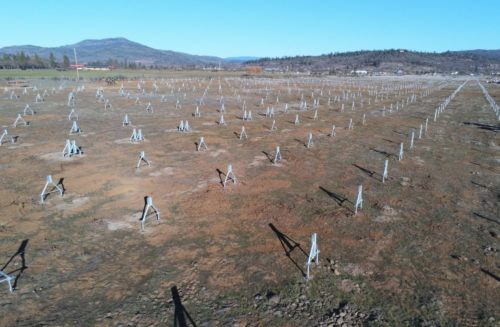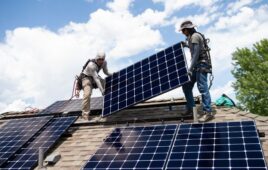Solar trackers are a common solution for large-scale solar projects, with contractors typically using an I-beam as the mounting foundation choice. As installers break into new markets like the Northeast, where the soil is rocky and ground frost is a risk, the depths I-beams must be driven for proper pull-resistance increases significantly.
Many solar mounting and racking manufacturers offer alternative solutions when an easy I-beam installation just won’t fly. Two such companies, TerraSmart and APA Solar Racking, have engineered foundational and full system A-frame solutions to address the issue of putting solar trackers on sites with too soft, too rocky and frost-heave susceptible soils.
A tracker designed around ground screws
TerraSmart has cut its teeth in the solar mounting market with its ground screws. The turnkey manufacturer, installer and geotechnical services provider has made the ground screw the foundation of its company, and the same holds true for its entry into solar tracking.

TerraSmart spent several years engineering a full single-axis solar tracker system that could use the company’s proprietary ground screw foundation. TerraSmart
TerraTrak is TerraSmart’s proprietary single-axis solar tracker and parent company Gibraltar Industries’ flagship tracking solution. The system has an A-frame-style footing that uses two ground screws rather than one driven pile to disperse tracker loads across two smaller supports.
“I’ve seen other trackers out there that are modified through some sort of interface to work with a ground screw, but everything from our first design meeting on included the mentality that we’re going to be using ground screws,” said Chase Anderson, senior design engineer, TerraSmart. “We need a tracker that can go in places where driven piles can’t.”
Now, after four years of development, TerraTrak is a fully realized single-axis tracker system with a proprietary design, network controller and monitoring software.
While there’s more to it than its mounts, the ground screws TerraTrak stands on are designed to work in rocky, soft/sandy and frost-ridden soils. The threaded section has more tension in softer soils and creates a cone that resists upward force; and with a cored pilot hole, ground screws can be driven and threaded directly into rocks.
“If you look at the type of sites that are available, especially in the Northeast United States, there’s not a lot of big, flat land left, and if there is, it’s going to farming and other purposes,” Anderson said. “TerraTrak is really good at providing a solution for clients that allows them to install a tracker on land that may not have been considered before because it has too much terrain, too much outcropping — things that TerraTrak handles well.”
TerraSmart has used telescoping legs with its ground screws for a decade on its fixed-tilt structures and brought that feature to TerraTrak, making the system adjustable within the posts’ material length. The tracker is designed to adapt to undulating topographies, meeting slopes up to 20%. Ground screws are driven early in the installation process, making system height something that can be determined later.
TerraTrak’s monitoring software provides necessary services like weather analytics, current system output and predictive maintenance. The software can halt operations in sections so technicians can perform spot maintenance while the remaining system continues to produce; and it can stow modules during high wind and weather events. TerraTrak has already been updated to house large-format modules and uses screw-free mounting clips that can essentially be hammered on to keep panels in place.
“We as a company offer full turnkey service in terms of foundations and racking for the fixed-tilt market,” said Michael Faraone, director of engineering for TerraSmart. “We went ahead and did the same thing for the tracker industry where we offer full turnkey from engineering, design, foundations, manufacturing of the tracker and installation of it.”
More footing for single-axis trackers
APA Solar Racking developed its A-Frame Tracker Foundation after hearing customer demand for a mounting structure for single-axis trackers that used helical piers or ground screws.

APA Solar Racking developed a footing that adapts to popular single-axis trackers, giving those systems the option to use ground screws or helical pile foundations. APA Solar Racking
“We started developing some concepts and different designs and really decided that this thing’s got to be light and cost-effective because we’re competing with basically a mill-run beam with a couple holes punched in it,” said Joe Von Deylen, COO of APA Solar Racking.
Where TerraSmart wanted to build an all-in-one system, APA is offering a foundational solution to work with popular tracking models. The attachment point of the A-Frame foundation uses a standard W section with the same hole patterns compatible with tracking structures offered by Nextracker and Array Technologies.
“You can physically take an A-Frame and put it right in the field in a row of driven piles and they’ll match and bolt exactly the same,” Von Deylen said.
In those circumstances where soils don’t have strong initial upward tension on an I-beam, helical piers and ground screws are designed to embed at shallower depths. APA’s helical mounts use a helix or flange mounted near the bottom of the post to similarly create a cone of tension above it to resist pullout.
APA encountered single-axis solar projects where geotechnical reports recommended installers drive I-beams to depths of nearly 20 ft.
“The issue with that is even if you can get equipment big enough to drive a pile that deep in the ground, more than likely, you’re going to hit something before it gets to depth,” Von Deylen said.
Then, other concerns are raised from accurately pounding I-beams to that depth and at the correct angle.
“If they can’t do that, they’re going back through and they’re bumping the piles to get them plumbed up to within specifications,” Von Deylen said. “Over time, the pile is going to just go back to where it naturally wants to go.”
Given the varying topographical features of solar sites, APA manufactures A-Frames on a per-project basis. The APA A-Frame uses a leveling flange at the bottom of the structure to adjust its height independent of the helical or ground screws.
Ultimately, APA and TerraSmart are trying to give single-axis solar projects footing with a consistent embedment in soil conditions that would otherwise require posts being driven to great depths or major geotechnical work. Installers can now look to multiple mounting solutions for what might have been unworkable land.





Tell Us What You Think!